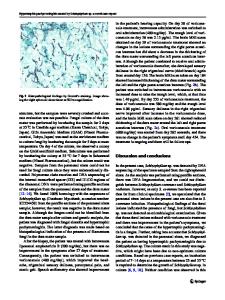A human corneal ulcer caused by Thelazia callipaeda in Southwest China: case report
- PDF / 548,818 Bytes
- 4 Pages / 595.276 x 790.866 pts Page_size
- 83 Downloads / 263 Views
HELMINTHOLOGY - SHORT COMMUNICATION
A human corneal ulcer caused by Thelazia callipaeda in Southwest China: case report Xiaoxing Wei 1,2 & Bo Liu 1,2 & Yijian Li 1,2 & Ke Wang 1,2 & Lixia Gao 1,2 & Yuli Yang 1,2 Received: 21 May 2020 / Accepted: 9 August 2020 # Springer-Verlag GmbH Germany, part of Springer Nature 2020
Abstract In this study, we describe a rare human case with corneal ulcer caused by thelaziosis in a 69-year-old man in Southwest China. A male nematode was discovered and removed from the patient’s right eye with a long spicule and further identified by sequencing mitochondrial cox1 gene. The ophthalmologic and molecular biological evidence demonstrates the corneal ulcer caused by T. callipaeda infection, which is mainly distributed in Asian and European countries. Most T. callipaeda infections are emerged in the conjunctiva, leading to conjunctivitis. To the best knowledge of the authors, corneal ulcers caused by T. callipaeda have not been reported yet. Keywords Thelazia callipaeda . Thelaziosis . Corneal ulcer
Introduction Corneal ulcer is an ophthalmic disease with high morbidity. It is estimated that approximately 1.5 million cases of corneal ulcer occurred each year in the developing countries (Basak et al. 2005). Many causes such as trauma, contact lenses, recent corneal surgery, ocular surface disease, chronic use of topical medication, and systemic immunosuppression are endogenous risk factors for corneal ulceration (Cheng et al. 1999). Compared with viral, bacterial, and fungal corneal ulcers, corneal ulcers caused by nematodes are rare but sight-threatening. Thelazia callipaeda (Spirurida: Thelaziidae) is an ectoparasite of animal’s (e.g., canids, felids, rodents) and human’s Xiaoxing Wei and Bo Liu contributed equally to this work. Section Editor: David Bruce Conn Electronic supplementary material The online version of this article (https://doi.org/10.1007/s00436-020-06850-w) contains supplementary material, which is available to authorized users. * Yuli Yang [email protected] 1
Medical College of Qinghai University, Xining 810016, People’s Republic of China
2
Department of Ophthalmology, Southwest Hospital/Southwest Eye Hospital, Third Military Medical University (Army Medical University), Chongqing 400038, People’s Republic of China
eyes, causing thelaziosis, a vector-borne zoonosis. Since the first human cases of thelaziosis were reported in India (1910) and in China (1917), more than 1000 cases have been reported in Asia (e.g., China, Korea, India, Thailand, and Japan) and sporadic cases in Europe (e.g., the former Soviet Republics, Italy, France, Spain, and Serbia) (reviewed by Shen et al. 2006). Most cases were reported in areas with poor socioeconomic and sanitary conditions (Tasić-Otašević et al. 2016). Due to its geographical distribution, T. callipaeda has been known as the “oriental eyeworm” for a long time. T. callipaeda is usually localized in the orbital cavity and associated tissues and transmitted exclusively by the secretophagous flies Phortica variegata (Drosoph
Data Loading...











